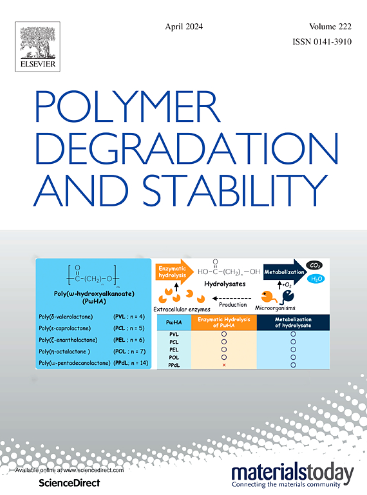在阻燃剂上引入聚硅氧烷涂层,实现聚丙烯的持久抗紫外线和阻燃性能
IF 6.3
2区 化学
Q1 POLYMER SCIENCE
引用次数: 0
摘要
聚丙烯(PP)的可燃性和抗紫外线老化能力差严重限制了其应用。三聚氰胺溴化氢(MHB)和次磷酸铝(AHP)是广泛使用的增效阻燃剂。受阻胺光稳定剂(HALS)通常用作聚烯烃的抗紫外线剂。然而,酸性MHB和碱性HALS的直接结合诱导拮抗相互作用,导致材料性能恶化。在这项工作中,用聚硅氧烷(Si-MHB)涂覆MHB可以减轻拮抗作用。此外,聚硅氧烷层可以改善阻燃剂与PP之间的相容性,从而提高阻燃性和力学性能。制备了含有Si-MHB、AHP和HALS衍生物的PP复合材料。在紫外线照射60 h后,PP/Si-MHB/AHP/HALS119表面保持相对光滑,并有一些浅裂纹。水接触角保持在92°,羰基指数降至10.45,说明光降解程度明显低于对照样品。PP/Si-MHB/AHP/HALS119的极限氧指数(LOI)高达26.5%。紫外线照射60 h后,LOI降至24.8%,仍保持UL-94 V-0等级,拉伸强度和冲击强度分别下降7%和10.2%,与对照样品相比下降幅度明显降低。以上结果表明,涂层聚硅氧烷可以有效缓解MHB与HALS119之间的拮抗作用,有效提高PP复合材料的抗紫外线老化性能、阻燃性能和力学性能。本文章由计算机程序翻译,如有差异,请以英文原文为准。

Introducing a polysiloxane coating on flame retardant to realize durable UV resistance and flame retardancy of polypropylene
The applications of polypropylene (PP) are severely limited by its flammability and poor resistance to UV aging. Melamine hydrogen bromide (MHB) and aluminum hypophosphite (AHP) are widely used as synergistic flame retardants. Hindered amine light stabilizers (HALS) are typically used as anti-UV agents for polyolefins. However, the direct combination of acidic MHB and basic HALS induces antagonistic interactions, leading to a deterioration in material performance. In this work, antagonism is mitigated by coating MHB with polysiloxane (Si-MHB). Moreover, the polysiloxane layer can improve the compatibility between the flame retardant and PP, thereby enhancing flame retardancy and mechanical properties. PP composites containing Si-MHB, AHP, and HALS derivative were prepared. After 60 h of UV exposure, the surface of PP/Si-MHB/AHP/HALS119 remained relatively smooth with some shallow cracks. The water contact angle was maintained at 92°, and the carbonyl index decreased to 10.45, pointing out that the degree of photodegradation was significantly lower than that observed in the control samples. Besides, the limiting oxygen index (LOI) of PP/Si-MHB/AHP/HALS119 reached up to 26.5 %. After 60 h of UV irradiation, LOI decreased to 24.8 % and still maintained UL-94 V-0 rating, the tensile strength and impact strength decreased by 7 % and 10.2 %, which was a significantly lower reduction compared to the control samples. The above results demonstrate that the coating polysiloxane can effectively mitigate the antagonistic interactions between MHB and HALS119, effectively enhancing the UV aging resistance, flame retardancy, and mechanical properties of PP composites.
求助全文
通过发布文献求助,成功后即可免费获取论文全文。
去求助
来源期刊

Polymer Degradation and Stability
化学-高分子科学
CiteScore
10.10
自引率
10.20%
发文量
325
审稿时长
23 days
期刊介绍:
Polymer Degradation and Stability deals with the degradation reactions and their control which are a major preoccupation of practitioners of the many and diverse aspects of modern polymer technology.
Deteriorative reactions occur during processing, when polymers are subjected to heat, oxygen and mechanical stress, and during the useful life of the materials when oxygen and sunlight are the most important degradative agencies. In more specialised applications, degradation may be induced by high energy radiation, ozone, atmospheric pollutants, mechanical stress, biological action, hydrolysis and many other influences. The mechanisms of these reactions and stabilisation processes must be understood if the technology and application of polymers are to continue to advance. The reporting of investigations of this kind is therefore a major function of this journal.
However there are also new developments in polymer technology in which degradation processes find positive applications. For example, photodegradable plastics are now available, the recycling of polymeric products will become increasingly important, degradation and combustion studies are involved in the definition of the fire hazards which are associated with polymeric materials and the microelectronics industry is vitally dependent upon polymer degradation in the manufacture of its circuitry. Polymer properties may also be improved by processes like curing and grafting, the chemistry of which can be closely related to that which causes physical deterioration in other circumstances.
 求助内容:
求助内容: 应助结果提醒方式:
应助结果提醒方式:


